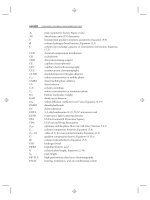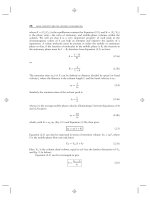Introduction to Modern Liquid Chromatography, Third Edition part 1 pdf
Bạn đang xem bản rút gọn của tài liệu. Xem và tải ngay bản đầy đủ của tài liệu tại đây (294.03 KB, 10 trang )
INTRODUCTION TO
MODERN LIQUID
CHROMATOGRAPHY
Third Edition
LLOYD R. SNYDER
LC Resources, Inc.
Orinda, CA
JOSEPH J. KIRKLAND
Advanced Materials Technology
Wilmington, DE
JOHN W. DOLAN
LC Resources, Inc.
Amity, OR
A John Wiley & Sons, Inc., Publication
INTRODUCTION TO
MODERN LIQUID
CHROMATOGRAPHY
Third Edition
INTRODUCTION TO
MODERN LIQUID
CHROMATOGRAPHY
Third Edition
LLOYD R. SNYDER
LC Resources, Inc.
Orinda, CA
JOSEPH J. KIRKLAND
Advanced Materials Technology
Wilmington, DE
JOHN W. DOLAN
LC Resources, Inc.
Amity, OR
A John Wiley & Sons, Inc., Publication
Copyright © 2010 by John Wiley & Sons, Inc. All rights reserved.
Published by John Wiley & Sons, Inc., Hoboken, New Jersey.
Published simultaneously in Canada.
No part of this publication may be reproduced, stored in a retrieval system, or transmitted in any
form or by any means, electronic, mechanical, photocopying, recording, scanning, or otherwise,
except as permitted under Section 107 or 108 of the 1976 United States Copyright Act, without
either the prior written permission of the Publisher, or authorization through payment of the
appropriate per-copy fee to the Copyright Clearance Center, Inc., 222 Rosewood Drive, Danvers,
MA 01923, (978) 750-8400, fax (978) 750-4470, or on the web at www.copyright.com. Requests
to the Publisher for permission should be addressed to the Permission Department, John Wiley &
Sons, Inc., 111 River Street, Hoboken, NJ 07030, (201) 748-6011, fax (201) 748-6008, or online at
/>Limit of Liability/Disclaimer of Warranty: While the publisher and author have used their best efforts
in preparing this book, they make no representations or warranties with respect to the accuracy
or completeness of the contents of this book and specifically disclaim any implied warranties of
merchantability or fitness for a particular purpose. No warranty may be created or extended by sales
representatives or written sales materials. The advice and strategies contained herein may not be
suitable for your situation. You should consult with a professional where appropriate. Neither the
publisher nor author shall be liable for any loss of profit or any other commercial damages, including
but not limited to special, incidental, consequential, or other damages.
For general information on our other products and services or for technical support, please contact
our Customer Care Department within the United States at (800) 762-2974, outside the United States
at (317) 572-3993 or fax (317) 572-4002.
Wiley also publishes its books in a variety of electronic formats. Some content that appears in print
may not be available in electronic formats. For more information about Wiley products, visit our web
site at www.wiley.com.
Library of Congress Cataloging-in-Publication Data:
Snyder, Lloyd R.
Introduction to modern liquid chromatography / Lloyd R. Snyder, Joseph J. Kirkland. – 3rd
ed. / John W. Dolan.
p. cm.
Includes index.
ISBN 978-0-470-16754-0 (cloth)
1. Liquid chromatography. I. Kirkland, J. J. (Joseph Jack), 1925- II. Dolan, John W. III.
Title.
QD79.C454S58 2009
543
.84–dc22
2009005626
Printed in the United States of America.
10987654321
CONTENTS
PREFACE xxxi
GLOSSARY OF SYMBOLS AND ABBREVIATIONS xxxv
1 INTRODUCTION 1
1.1
Background Information, 2
1.1.1 What Is HPLC?, 2
1.1.2 What Can HPLC Do?, 4
1.2 A Short History of HPLC, 6
1.3 Some Alternatives to HPLC, 8
1.3.1 Gas Chromatography (GC), 8
1.3.2 Thin-Layer Chromatography (TLC), 9
1.3.3 Supercritical Fluid Chromatography
(SFC), 10
1.3.4 Capillary Electrophoresis (CE), 11
1.3.5 Countercurrent Chromatography, 11
1.3.6 Special Forms of HPLC, 12
1.4 Other Sources of HPLC Information, 12
1.4.1 Books, 12
1.4.2 Journals, 13
1.4.3 Reviews, 13
1.4.4 Short Courses, 13
1.4.5 The Internet, 13
References, 15
2 BASIC CONCEPTS AND THE CONTROL OF SEPARATION 19
2.1
Introduction, 20
2.2 The Chromatographic Process, 20
2.3 Retention, 24
v
vi CONTENTS
2.3.1 Retention Factor k and Column Dead-Time
t
0
,25
2.3.2 Role of Separation Conditions and Sample
Composition, 28
2.3.2.1 Intermolecular Interactions, 30
2.3.2.2 Temperature, 34
2.4 Peak Width and the Column Plate Number N,35
2.4.1 Dependence of N on Separation
Conditions, 37
2.4.1.1 Band-Broadening Processes That
Determine Values of N,39
2.4.1.2 Some Guidelines for Selecting
Column Conditions, 46
2.4.2 Peak Shape, 50
2.5 Resolution and Method Development, 54
2.5.1 Optimizing the Retention Factor k,57
2.5.2 Optimizing Selectivity α,59
2.5.2.1 ‘‘Regular’’ and ‘‘Irregular’’
Samples, 60
2.5.3 Optimizing the Column Plate Number N,61
2.5.3.1 Effects of Column Conditions on
Separation, 61
2.5.3.2 Fast HPLC, 63
2.5.4 Method Development, 65
2.5.4.1 Assessment of Sample
Composition and Separation
Goals, 65
2.5.4.2 Sample Pretreatment, 66
2.5.4.3 Selection of Chromatographic
Mode, 66
2.5.4.4 Detector Selection, 66
2.5.4.5 Choice of Separation
Conditions, 67
2.5.4.6 Anticipation, Identification, and
Solution of Potential
Problems, 67
2.5.4.7 Method Validation and System
Suitability, 69
2.6 Sample Size Effects, 69
2.6.1 Volume Overload: Effect of Sample Volume
on Separation, 70
2.6.2 Mass Overload: Effect of Sample Weight on
Separation, 71
CONTENTS vii
2.6.3 Avoiding Problems due to Too Large a
Sample, 73
2.6.3.1 Higher Than Expected Sample
Concentrations, 73
2.6.3.2 Trace Analysis, 73
2.7 RELATED TOPICS, 74
2.7.1 Column Equilibration, 74
2.7.2 Gradient Elution, 75
2.7.3 Peak Capacity and Two-dimensional
Separation, 76
2.7.4 Peak Tracking, 77
2.7.5 Secondary Equilibria, 78
2.7.6 Column Switching, 79
2.7.7 Retention Predictions Based on Solute
Structure, 80
2.7.7.1 Solvation-Parameter Model, 82
References, 83
3 EQUIPMENT 87
3.1
Introduction, 88
3.2 Reservoirs and Solvent Filtration, 89
3.2.1 Reservoir Design and Use, 90
3.2.2 Mobile-Phase Filtration, 91
3.3 Mobile-Phase Degassing, 92
3.3.1 Degassing Requirements, 92
3.3.2 Helium Sparging, 94
3.3.3 Vacuum and In-line Degassing, 95
3.4 Tubing and Fittings, 96
3.4.1 Tubing, 96
3.4.1.1 Low-Pressure Tubing, 96
3.4.1.2 High-Pressure Tubing, 97
3.4.2 Fittings, 99
3.4.2.1 Low-Pressure Fittings, 99
3.4.2.2 High-Pressure Fittings, 101
3.4.2.3 Specialty Fittings, 103
3.5 Pumping Systems, 104
3.5.1 Reciprocating-Piston Pumps, 104
3.5.1.1 Dual-Piston Pumps, 108
3.5.1.2 Accumulator-Piston Pumps, 108
3.5.1.3 Active Check Valve, 109
3.5.2 On-line Mixing, 109
3.5.2.1 High-Pressure Mixing, 109
3.5.2.2 Low-Pressure Mixing, 111
3.5.2.3 Hybrid Systems, 111









